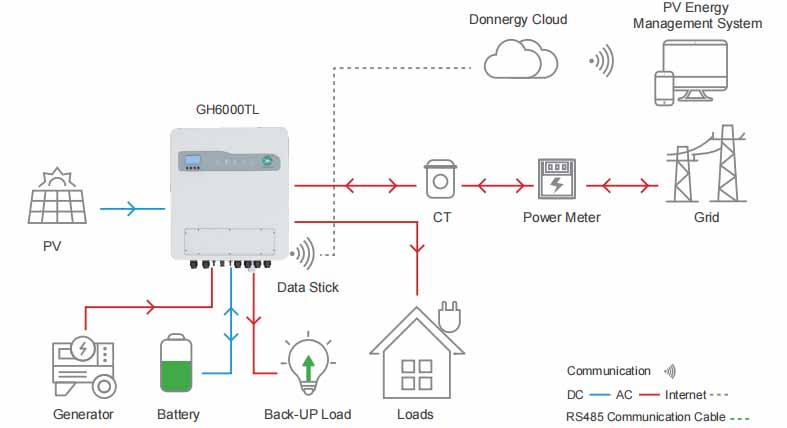What is Hybrid Inverter?
Hybrid inverter is a device that combines solar panels, utility power, and energy storage batteries into one power system, which enables the intelligent processing of power from solar panels, batteries, and the utility grid at the same time, using different power sources intelligently according to the settings of the hybrid inverter.
The direct current (DC) power generated by the photovoltaic (PV) system is converted by the hybrid inverter into alternating current (AC) power for home power supply, which can also be stored for backup power use, and the excess power generated can also be delivered to the utility grid for benefits.
Solar hybrid inverters integrate all functions into one device, making the work of traditional solar inverters easier and more efficient. These functions include grid connection and solar panel charging. Another advantage is that since the amount of solar energy generated varies with weather and seasons, the hybrid inverter can draw power from the grid when necessary to charge the battery storage system according to different power generation situations, This is the most obvious advantage of a hybrid inverter.

Type of Hybrid Inverter and work diagram
Before deciding to use a hybrid inverter, you need to understand the two types of hybrid inverters, The grid here refers to the public grid, It will be easier to understand when the types are introduced below.
Off grid hybrid inverter
As the name suggests, the off-grid hybrid inverter does not supply excess electricity to the public power supply. It is the most commonly used type of hybrid inverter. This device is mainly powered by an inverter and an energy storage battery. When the power provided by the solar panels and batteries is insufficient, it will supplement the power from the public grid. This solution can be considered when the power cost is too high.

Off grid and On grid hybrid inverter
As introduced above, the off-grid and on grid hybrid inverter
has all the functions of the off-grid hybrid inverter, and in addition, it has an additional function, which can transmit the excess power generated to the public power supply to obtain income, meet its own power usage, and sell the excess power completely to obtain more income.

What is it different nomarl inverter
A traditional inverter is a device that uses switches and control circuits to convert direct current (DC) electricity stored in batteries into alternating current (AC). It is mainly used in residential emergency and commercial power systems.
The power inverter takes DC power from the battery and then converts it into AC power used by electrical appliances. The inverter battery and inverter are usually connected to the power connection of your home. When there is power in the network or grid, the battery will charge. When there is no power, the inverter will automatically switch to battery mode (in most cases) to allow you to use electrical appliances and other necessities.
Solar inverters can obtain clean solar power and monitor power operation in real time
Hybrid inverter advantages and disadvantages
Advantages
(1) Flexibility in power use
One of the main advantages of hybrid inverters is that it can use electricity flexibly. It can store electrical energy in power storage devices and automatically switch to use during power outages or peak hours when electricity prices are high. This means that even if the grid is out of power, you can still get reliable power. At the same time, you can choose to sell it during peak power hours to get greater profits.
(2) Easy to upgrade battery storage
Another advantage of hybrid inverters is that they can easily expand battery storage. When you need to expand battery storage in the future, you don’t need to replace the existing inverter equipment. You can easily adjust the solar power generation system by expanding or reducing it as demand changes.
(3) Convenient energy monitoring
Hybrid inverters have optimized energy monitoring. Now, hybrid inverters are directly connected to the Internet for monitoring, allowing you to monitor solar power generation systems and battery storage from a single interface. This makes it easy to track the amount of energy you generate and use, and helps you optimize energy use for maximum efficiency.
Disadvantages
(1) Inability to upgrade existing systems
If you already have a solar power generation system with an off-grid hybrid inverter, it may not be cost-effective to upgrade to an off-grid and on grid hybrid inverter.
(2) Increased equipment costs
Another disadvantage of hybrid inverters is that they cost more to purchase than microinverters. This is because they require additional equipment (such as batteries) to work effectively. When deciding whether a hybrid inverter is right for you, you need to consider the cost of these additional components, as well as your future electricity usage.
(3) Lack of flexibility
If you plan to continue to add solar panels in the future, this will be difficult to achieve with a hybrid inverter because it is designed for a specific number of solar panels and energy storage batteries. The power handled by the inverter and the total amount of battery storage cannot be upgraded simultaneously, and the equipment and the total amount of batteries need to be upgraded.
Last
If the following situations or needs occur, you can consider using a hybrid inverter
- Public power is unstable, and electricity consumption requires high stability
- Unable to afford high electricity bills
- No more solar power system upgrade needs in the next few years




